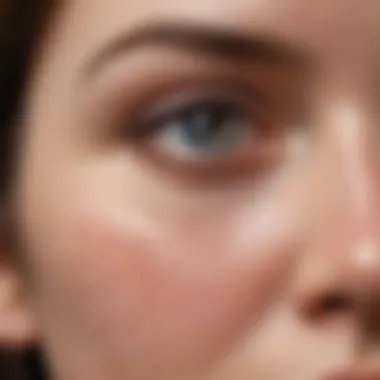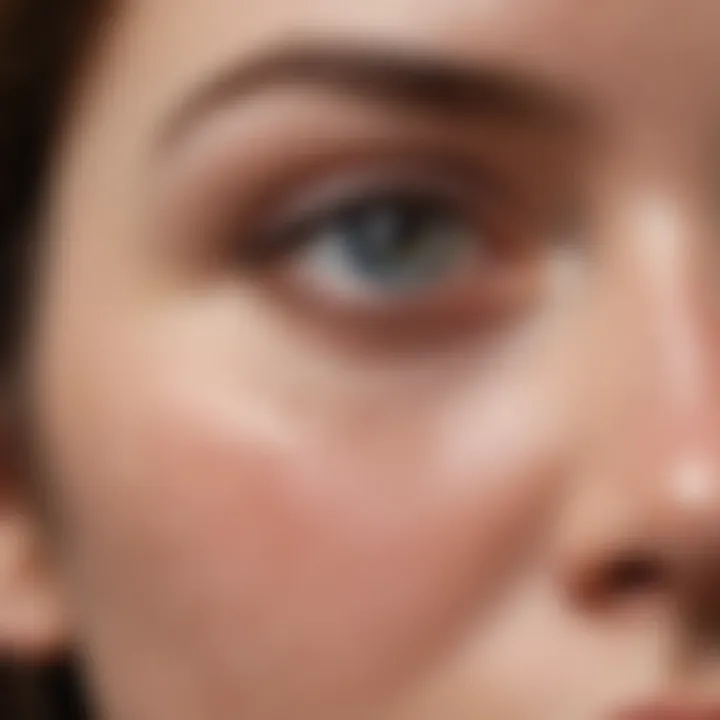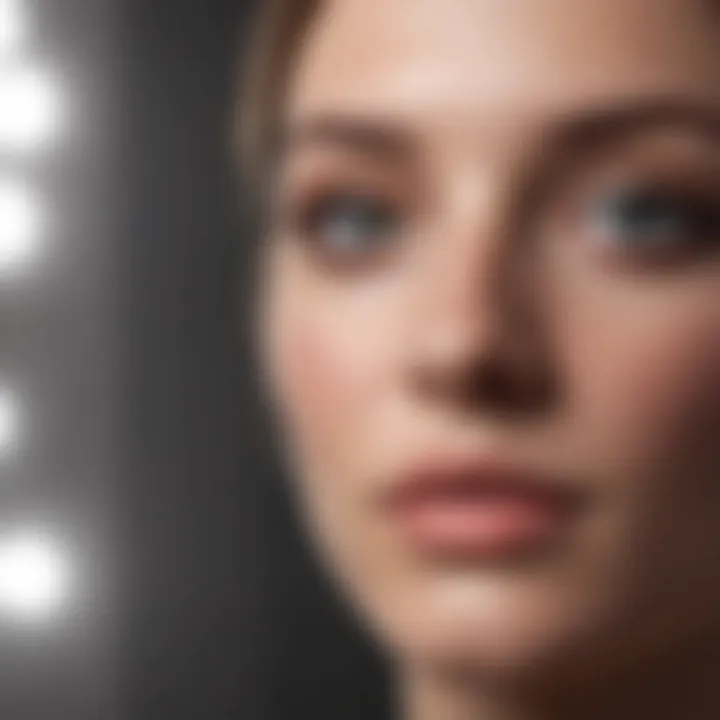Assessing Proactiv's Efficacy for Blackhead Treatment


Intro
Blackheads present a significant concern for many seeking clearer skin. They form when hair follicles become clogged with oil and dead skin cells. Proactiv, a well-known skincare line, claims to address this issue effectively. In this article, we will evaluate the effectiveness of Proactiv on blackheads. We will analyze its ingredients, mechanisms of action, user testimonials, and any potential risks involved. Moreover, we will look into alternatives, providing a comprehensive guide for those considering Proactiv as a treatment option.
Key Trends
Overview of Current Skincare Trends
Skincare is no longer a mere routine; it has evolved into a cultural phenomenon. Consumers are increasingly aware of the ingredients in their products. Transparency and functionality are key drivers in the current market. As this trend grows, many gravitate toward science-backed solutions like Proactiv.
Popular Beauty Trends
In the realm of beauty products, minimalism is becoming a notable trend. Many consumers opt for fewer, more effective solutions. They prioritize multifunctional products that can address multiple concerns simultaneously. Proactiv aims to cater to this demand but also faces critiques regarding its efficacy and suitability for everyone.
Understanding Proactiv's Ingredients
Proactiv's formulation includes salicylic acid, benzoyl peroxide, and glycolic acid. Each ingredient serves a specific purpose:
- Salicylic Acid: Targets dead skin cells and penetrates pores to prevent clogging.
- Benzoyl Peroxide: Helps eliminate bacteria that can cause breakouts.
- Glycolic Acid: Exfoliates the skin's surface, promoting cell turnover.
Mechanisms of Action
Understanding how Proactiv's ingredients work can elucidate their effectiveness against blackheads.
- Exfoliation: The combination of glycolic and salicylic acid gently removes dead skin cells. This action helps prevent new blackheads from forming.
- Pore Cleansing: Salicylic acid helps to dissolve the substance that clogs pores, reducing the likelihood of blockages.
- Bacterial Control: Benzoyl peroxide's antibacterial properties help minimize infection risk, promoting clearer skin.
"Regular use of exfoliating agents like glycolic and salicylic acids can yield significant improvements in skin texture and clarity."
User Experiences
Reviews of Proactiv reveal a mixed bag of results. Many users report a noticeable reduction in blackheads. However, some experience irritation or dryness, particularly with initial use. It is essential to start with lower concentrations and gradually increase exposure.
Pros and Cons of Proactiv
- Pros:
- Cons:
- Effective in reducing blackheads for many users.
- Contains reputable active ingredients.
- Potential for irritation, especially for sensitive skin.
- Not everyone may find it suitable or effective.
Risks and Alternatives
While Proactiv offers a structured approach to treating blackheads, it comes with risks. Individuals with sensitive skin may find irritation persistent. Alternatives such as
- The Ordinary's Niacinamide or
- Paula's Choice BHA Liquid Exfoliant are popular choices. These products target blackheads effectively while potentially causing less irritation.
Recommendations for Treating Blackheads
When considering options to address blackheads, it is advisable to:
- Assess Your Skin Type: Understand if your skin is oily, dry, or sensitive.
- Look for Suitable Ingredients: Choose based on what your skin can tolerate.
- Investigate User Reviews: Seek out varied experiences to understand possible outcomes.
Finale
In summary, Proactiv can be effective for treating blackheads, depending on the individual's skin type and sensitivities. Its formulation works on the principle of exfoliation and pore cleansing. Nevertheless, it may not be ideal for everyone. Evaluating personal skin conditions and exploring alternatives will help in making an informed choice.
Intro to Blackheads


Blackheads are a widespread skincare issue affecting millions. Understanding them is crucial for anyone considering treatments like Proactiv. This section sets the foundation for our exploration of Proactiv's effectiveness in addressing blackheads by outlining key characteristics and implications.
Definition of Blackheads
Blackheads are small, dark blemishes that appear on the skin. They are a type of acne vulgaris, formed when hair follicles become clogged with excess oil (sebum) and dead skin cells. Unlike whiteheads, blackheads remain open at the surface, which exposes the clogged material to air. This exposure to oxygen causes it to oxidize and turn dark, giving rise to the name. Recognizing this basic definition helps clarify why effective treatments are essential for clear skin.
Causes of Blackheads
Several factors contribute to the formation of blackheads. One primary cause is the overproduction of sebum, which can be triggered by hormonal changes, particularly during puberty or menstruation. Additionally, inadequate cleaning of the skin leads to an accumulation of dead skin cells, which can also block pores. Other contributing factors include:
- Poor diet, particularly high in sugar and dairy
- Use of comedogenic skincare products
- Environmental pollutants
- Stress, which impacts hormonal balance
Awareness of these causes can guide individuals in making lifestyle adjustments that support better skin health.
Skin Types Prone to Blackheads
Certain skin types are more susceptible to developing blackheads. Oily skin is often the primary category, as excess sebum production can quickly lead to clogged pores. Additionally, those with combination skin, where both oily and dry areas exist, may find themselves battling blackheads in the oilier regions. It's also important to note that individuals with thicker skin or larger pores may experience more prevalent blackhead formation. Recognizing one’s skin type is critical for applying the right treatments effectively.
Overview of Proactiv
The section on the overview of Proactiv provides critical context in evaluating its effectiveness against blackheads. This understanding contributes significantly to the article as it lays the groundwork for comprehending the product's claims, usage, and potential suitability for different users. By focusing on the essence of Proactiv, readers can clarify their expectations when considering this treatment for skincare concerns, particularly blackheads.
What is Proactiv?
Proactiv is a well-known skincare brand, primarily recognized for its acne treatment products. It is designed to address various skin issues, notably acne and blackheads. Proactiv’s formulation typically includes ingredients such as benzoyl peroxide and salicylic acid, which are renowned for their anti-acne properties. Benzoyl peroxide works by killing acne-causing bacteria, while salicylic acid helps to exfoliate the skin and unclog pores. These ingredients work together for a clearer complexion.
Proactiv is marketed as a comprehensive skincare system, often encompassing a series of products that may include cleansers, toners, and moisturizers. Such a system aims to provide a multi-faceted approach to treating acne and promoting skin health. For many customers, Proactiv represents a targeted solution in their fight against blackheads, making it an interesting subject in the context of effectiveness evaluation.
Proactiv's Target Audience
Proactiv primarily targets individuals who struggle with acne-related issues, including blackheads. The audience ranges from teenagers facing hormonal changes to adults dealing with chronic skincare concerns. This demographic often seeks reliable solutions that promise efficiency and ease of use.
While Proactiv is formulated for various skin types, its popularity among young adults and teenagers stands out. This audience typically desires products that can fit seamlessly into their everyday routines. Additionally, those with oily skin may find Proactiv especially appealing due to its potent ingredients that can help control excess oil, a common contributor to blackheads.
In a broader sense, Proactiv aims to cater to anyone looking for an effective product against blackheads, whether through its dedicated skincare system or individual items. The accessibility of the products, often promoted via online platforms and social media, helps reach potential customers where they spend significant time. Ultimately, understanding who uses Proactiv and why helps to assess its effectiveness in addressing specific skincare challenges.
Key Ingredients in Proactiv
Understanding the key ingredients in Proactiv is crucial for evaluating its effectiveness against blackheads. These components play a significant role in how the product functions and interacts with the skin. The ingredients in skincare formulations directly affect their ability to address various skin concerns, including blackheads.
Benzoyl Peroxide
Benzoyl Peroxide is one of the main ingredients in Proactiv. It works primarily as an antibacterial agent, targeting the bacterium Propionibacterium acnes. This bacterium is often responsible for acne formation. By reducing the bacteria on the skin, Benzoyl Peroxide helps minimize inflammation and prevent clogged pores.
However, it is essential to note that benzoyl peroxide can cause some initial irritation. Users might experience redness, peeling, or dryness when first using products that contain it. Therefore, gradual introduction is recommended for those with sensitive skin. Additionally, users should avoid excessive sun exposure, as Benzoyl Peroxide may make the skin more susceptible to sunburn.
Salicylic Acid
Another vital ingredient in Proactiv is Salicylic Acid. This compound belongs to a class of medications known as beta hydroxy acids (BHAs). Its primary function is to exfoliate the skin and help unclog pores. By sloughing off dead skin cells, Salicylic Acid aids in preventing the formation of new blackheads. It is particularly effective for oily skin types, as it penetrates the pores and helps dissolve excess oil.
Moreover, Salicylic Acid possesses anti-inflammatory properties, which can soothe irritated skin. However, like Benzoyl Peroxide, it may cause dryness or peeling. Users should apply it carefully and monitor their skin’s reaction, adjusting usage accordingly.
Other Notable Ingredients
Apart from Benzoyl Peroxide and Salicylic Acid, Proactiv’s formulation includes other notable ingredients that contribute to its effectiveness. These may include soothing agents like Aloe Vera or Glycerin, which help counterbalance the drying effects of the active components.
- Aloe Vera helps calm the skin, reducing potential irritation.
- Glycerin acts as a humectant, drawing moisture to the skin and promoting hydration.
Understanding the roles of these ingredients aids in grasping how Proactiv can potentially improve skin quality by addressing blackheads and overall skin health.


Proactiv combines potent ingredients that not only target acne but also promote healthy skin through hydration and calming effects.
In summary, the key ingredients of Proactiv work in tandem to combat blackheads effectively. While Benzoyl Peroxide and Salicylic Acid play significant roles in addressing the root cause of blackheads, other ingredients are vital for maintaining skin balance and comfort.
Mechanism of Action
Understanding the mechanism of action behind Proactiv is crucial. This section aims to shed light on how the product operates to tackle blackheads effectively. By grasping the underlying processes, users can better appreciate its impact and make informed decisions regarding its use.
How Proactiv Targets Blackheads
Proactiv specifically focuses on blackheads by employing a dual approach that addresses both prevention and clearing of existing blockages. The product's formulation contains salicylic acid and benzoyl peroxide, two key ingredients with distinct functions.
- Salicylic Acid: This beta hydroxy acid penetrates the skin's pores, dissolving the debris that blocks them. It exfoliates the cells inside the pores, reducing the buildup of dead skin and oil that often leads to blackheads.
- Benzoyl Peroxide: This component not only helps in killing acne-causing bacteria but also aids in unblocking pores by promoting skin turnover. It accelerates the shedding of dead skin cells and opens clogged pores, facilitating a clearer complexion.
Thus, by combining these two potent ingredients, Proactiv seeks to eliminate existing blackheads while also preventing new ones from forming. This proactive strategy can be beneficial for individuals struggling with persistent blackhead issues.
Effect on Oily Skin
The effectiveness of Proactiv on oily skin requires special mention. Oily skin is characterized by overproduction of sebum, which often contributes to blackhead formation. The active ingredients in Proactiv specifically target this excess oiliness.
- Oil Control: Benzoyl peroxide works to reduce the overall oiliness on the skin, helping to balance the skin's natural oils. This is especially important for people with oily skin, as it directly affects the environment where blackheads thrive.
- Reduced Pore Size: The exfoliation properties of salicylic acid not only clean the pores but also make them appear smaller over time. Smaller pores can lead to less oil accumulation, thereby decreasing the chances of blackheads.
Users with oily skin may find Proactiv particularly beneficial. However, it is important to monitor the skin's reaction, as some people may experience increased dryness or sensitivity, necessitating a balanced approach in their skincare routine.
The combination of salicylic acid and benzoyl peroxide in Proactiv targets blackheads effectively by addressing both causes and symptoms associated with oily skin.
In summary, understanding how Proactiv functions can provide a more strategic approach to treating blackheads, especially for individuals dealing with oily skin.
User Experiences and Testimonials
User experiences and testimonials hold significant weight in assessing the overall effectiveness of Proactiv in treating blackheads. These narratives provide insight into real-life applications of the product, illustrating how it functions beyond clinical studies. They offer potential users a glimpse into various outcomes that others have experienced, thus influencing their perceptions and decisions. It is through these accounts that we can identify patterns, such as common benefits or recurring challenges associated with Proactiv.
In exploring user feedback, it is essential to consider the context in which the product was used. Individual skin types, adherence to the regimen, and concurrent products can all impact effectiveness. Understanding these elements might help others tailor their approach as they navigate their skincare journeys. Moreover, the sharing of experiences fosters a community of individuals seeking clearer skin, contributing to a broader conversation about skincare solutions.
Positive Feedback
Many users of Proactiv have reported favorable outcomes, particularly when addressing blackheads. These favorable results often include a noticeable reduction in blackhead visibility and overall improvement in skin texture. Positive testimonials frequently emphasize the following benefits:
- Efficacy: Users often mention a significant decrease in the number of blackheads after consistent use.
- Convenience: The structured regimen that Proactiv offers makes it easier for users to follow a skincare plan.
- Confidence: A common theme among satisfied users is the boost in self-esteem that clear skin can bring.
Some have shared transformative before-and-after photos, showcasing their clearer complexions. Many testimonials highlight how Proactiv not only managed to treat existing blackheads but also helped prevent new ones from forming. Users express appreciation for the way they felt their skin improved progressively over time, reinforcing their belief in the product's long-term potential.
Challenges and Disappointments
Despite the positive feedback, not all experiences with Proactiv have been favorable. Some users have encountered considerable challenges or experienced disappointments that merit attention. These factors include:
- Skin Irritation: A segment of users reports dryness or irritation, particularly during the initial weeks of use.
- Ineffectiveness: Not every user witnesses the same level of success, leading some to feel the product does not meet their expectations.
- Consistency Issues: Individuals may struggle to maintain the regimen, impacting results. The commitment required can be challenging for users with tight schedules.
These challenges underscore the importance of individual differences in skin type and condition. Engaging with both sides of the user experience narrative provides a more comprehensive understanding of Proactiv's effectiveness. This balanced perspective aids potential users in making informed decisions while setting realistic expectations for their skincare journey.
Potential Side Effects
Evaluating the potential side effects of Proactiv is vital for users considering its efficacy in treating blackheads. Understanding these risks allows individuals to make informed decisions regarding their skincare regimen. While many users report positive outcomes, there are also some who experience adverse effects. These effects can vary in intensity and duration, often depending on skin type and sensitivity.
Skin Irritation
Skin irritation is a frequently reported side effect among users of Proactiv. This reaction can manifest as redness, dryness, flaking, or a burning sensation upon application. Individuals with sensitive skin or pre-existing skin conditions may be particularly susceptible to irritation.


To mitigate skin irritation, it is recommended that users gradually introduce Proactiv into their routine. Starting with less frequent applications can help the skin adjust to the active ingredients. Additionally, complementing Proactiv with a gentle moisturizer can aid in maintaining skin hydration.
Signs of severe irritation should not be overlooked. If symptoms persist or worsen, it is advisable to discontinue use and consult a dermatologist for tailored advice.
Allergic Reactions
Although rare, some individuals may experience allergic reactions to Proactiv's ingredients. Symptoms of an allergic reaction can include hives, swelling, or severe itching. In serious cases, it might lead to anaphylaxis, a life-threatening condition requiring immediate medical attention.
To minimize the risk of allergic reactions, performing a patch test before utilizing the entire product line is beneficial. Applying a small amount on a discreet area of skin can help identify any adverse reactions before full application. Users should also familiarize themselves with the ingredients listed on the Proactiv packaging, paying special attention to any known allergens.
"Investigating and understanding the side effects of a skincare product is as crucial as knowing its benefits."
Recognizing potential side effects is an integral part of the evaluation process. It allows consumers to weigh the positive impacts of Proactiv against the risks of irritation and allergic reactions. This knowledge empowers users to make confident choices in their pursuit of clearer skin.
Alternative Treatments for Blackheads
Blackheads are a persistent issue for many individuals. While Proactiv offers a range of solutions, it’s essential to explore alternative treatments. Understanding these alternatives enables users to make informed decisions about their skincare regimen. Such treatments can often complement or act as substitutes for Proactiv, catering to different skin types and personal preferences. This section will discuss topical solutions and professional options for managing blackheads.
Topical Solutions
Topical treatments are frequently the first line of defense against blackheads. They are easy to apply and can be purchased over-the-counter in many cases. Here are some common ingredients found in topical solutions that target blackheads:
- Salicylic Acid: A well-known ingredient in many acne products, salicylic acid helps to exfoliate the skin’s surface. Its oil-soluble nature allows it to penetrate the pores, breaking down the debris that leads to blackheads.
- Retinoids: These vitamin A derivatives promote cell turnover. By speeding up the shedding of dead skin cells, they help prevent the clogging of pores.
- Glycolic Acid: As an alpha hydroxy acid, glycolic acid aids in exfoliation. It reduces the appearance of blackheads by keeping the skin smooth and preventing new blemishes.
- Benzoyl Peroxide: Although primarily known for treating active acne, benzoyl peroxide can also be useful against blackheads due to its ability to kill bacteria and help clear pores.
Using these topical solutions can yield significant improvements in the appearance of the skin. It's crucial to use them consistently and combine them with a proper skincare routine for maximum effect. However, individuals with sensitive skin should apply these treatments with caution, as they may cause irritation.
Professional Options
For those who seek immediate results or have had little success with over-the-counter products, professional treatments are available. These options often provide more intensive care and can be customized to individuals' unique skin conditions.
- Chemical Peels: This treatment involves applying a solution that exfoliates the outer layer of skin. Chemical peels help remove impurities and dead skin, making it easier to manage blackheads and other blemishes.
- Microdermabrasion: A non-invasive procedure, microdermabrasion utilizes small crystals to exfoliate the skin mechanically. It can improve overall skin texture and unclog pores, reducing the likelihood of blackheads.
- Extractions: In professional settings, licensed estheticians can perform extractions to manually remove blackheads. This method is effective for those with stubborn blemishes, ensuring clean pores. However, it is advisable to undergo this treatment in a sterile environment to avoid complications.
- Laser Treatments: Certain laser therapies can target oil production in the skin, thereby reducing the frequency of blackheads. This option is generally more expensive but offers a longer-lasting solution for many individuals.
In summary, exploring alternative treatments for blackheads is beneficial. Each treatment type has its unique advantages and may work better for different individuals. Users should consider their skin type, severity of blackheads, and personal preferences when evaluating these options.
Combining Proactiv with Other Treatments
Combining Proactiv with other treatments can be an important strategy in tackling blackheads. People often seek to enhance the efficacy of their skincare routines by integrating multiple products. However, understanding how these interactions can improve results is crucial. The compatibility of ingredients, the timing of application, and the specific needs of one’s skin all play a vital role in determining the success of such combinations.
Synergistic Approaches
A synergistic approach involves using products that work together to enhance their overall effectiveness. When using Proactiv, certain complementary products may yield better results. Here are some considerations:
- Exfoliants: Incorporating gentle exfoliants can help remove dead skin cells. This can prevent clogged pores, thus reducing blackheads. Chemical exfoliants like glycolic acid or lactic acid can be particularly useful.
- Moisturizers: It might seem counterintuitive, but a suitable moisturizer can aid in balancing skin's hydration levels. A well-hydrated skin barrier can help reduce excess oil production, which is a contributing factor in blackhead formation.
- Spot Treatments: Specific products designed to target individual blemishes can be effective. For instance, using benzoyl peroxide or salicylic acid spot treatments may provide targeted effects without overwhelming the skin.
"Combining products can lead to greater results, but knowledge of each product's effects is essential for safe use."
Precautions When Mixing Products
While combining treatments has potential benefits, there are important precautions to consider. Mixing certain skincare products can lead to irritation or reduced effectiveness. Here are key precautions:
- Avoid Over-Exfoliation: Using multiple exfoliating products simultaneously can lead to skin irritation. It is vital to space out products and observe how skin responds.
- Know Your Skin Type: People with sensitive skin should exercise caution. Some combinations may trigger reactions or lead to inflammation.
- Patch Testing: Before fully integrating new products, perform a patch test. This can help identify potential adverse reactions early.
- Consult Professionals: It is often beneficial to consult a dermatologist for personalized advice. They can provide insights tailored to individual skin types and challenges.
Combining Proactiv with other treatments, when done thoughtfully, can provide comprehensive care for blackheads and overall skin health.
Closure
In the context of this article, the conclusion serves as a vital summarization of Proactiv's potential to combat blackheads. It encapsulates the findings and emphasizes the importance of understanding the product's efficacy before incorporating it into one’s skincare regimen. Evaluating the effectiveness of Proactiv requires consideration of multiple factors, including ingredient composition, user testimonials, potential side effects, and alternative treatments.
Final Thoughts on Proactiv's Efficacy
Overall, the product claims to provide a solution for managing blackheads, but results can vary among different individuals. The combination of benzoyl peroxide and salicylic acid in Proactiv shows promise in unclogging pores and reducing oil. However, its effectiveness might not be uniform across all skin types. Some users report positive outcomes, while others may experience skin irritation. It is crucial to remember that skin health is highly subjective, and what works for one person might not work for another. Thus, a careful examination of personal skin type and concerns is essential.
Recommendations for Users
When considering Proactiv for blackhead treatment, potential users should keep the following in mind:
- Consult a Dermatologist: Before starting any new treatment, especially if you have sensitive skin or are prone to reactions.
- Patch Testing: Always perform a patch test to determine if the product may cause irritation before full application.
- Follow Instructions: Adhere to the recommended usage to avoid oversaturation, which can lead to dryness or irritation.
- Maintain Realistic Expectations: While some users see improvement, results may vary and often take time to materialize.
- Consider Combination Treatments: For enhanced effectiveness, pairing Proactiv with alternative topical solutions or professional treatments may be beneficial.
Ultimately, an informed choice combined with patience will yield the best results for individuals seeking clearer skin.



